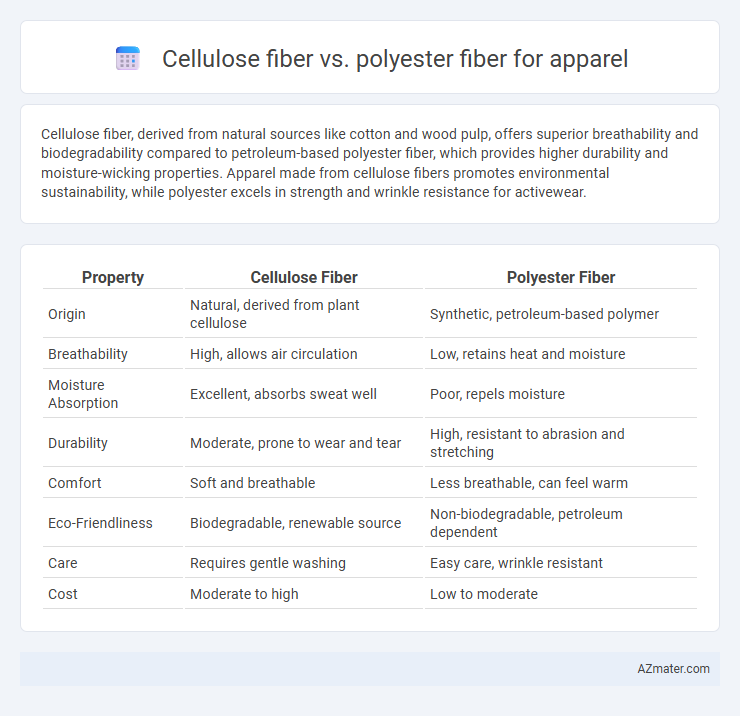Cellulose fiber, derived from natural sources like cotton and wood pulp, offers superior breathability and biodegradability compared to petroleum-based polyester fiber, which provides higher durability and moisture-wicking properties. Apparel made from cellulose fibers promotes environmental sustainability, while polyester excels in strength and wrinkle resistance for activewear.
Table of Comparison
| Property | Cellulose Fiber | Polyester Fiber |
|---|---|---|
| Origin | Natural, derived from plant cellulose | Synthetic, petroleum-based polymer |
| Breathability | High, allows air circulation | Low, retains heat and moisture |
| Moisture Absorption | Excellent, absorbs sweat well | Poor, repels moisture |
| Durability | Moderate, prone to wear and tear | High, resistant to abrasion and stretching |
| Comfort | Soft and breathable | Less breathable, can feel warm |
| Eco-Friendliness | Biodegradable, renewable source | Non-biodegradable, petroleum dependent |
| Care | Requires gentle washing | Easy care, wrinkle resistant |
| Cost | Moderate to high | Low to moderate |
Introduction to Cellulose and Polyester Fibers
Cellulose fibers, derived from natural sources like cotton, flax, and wood pulp, offer breathability, moisture absorption, and biodegradability, making them ideal for comfortable and eco-friendly apparel. Polyester fibers, synthetic polymers primarily sourced from petroleum, provide durability, wrinkle resistance, and quick-drying properties, widely used in activewear and performance garments. Comparing cellulose and polyester fibers highlights differences in sustainability, moisture management, and fiber strength, crucial for selecting appropriate materials in the textile industry.
Origin and Production Processes
Cellulose fiber, derived from natural sources such as cotton, wood pulp, or bamboo, undergoes chemical treatments like viscose or lyocell processes to regenerate fibers suitable for apparel manufacturing. Polyester fiber originates from petrochemical polymers, primarily polyethylene terephthalate (PET), produced through a polymerization process involving ethylene glycol and terephthalic acid, then melted and extruded into fibers. The renewable origin of cellulose contrasts with petroleum-based polyester, influencing sustainability profiles and production energy consumption in textile manufacturing.
Physical and Chemical Properties
Cellulose fiber, derived from natural sources like cotton and wood pulp, exhibits excellent moisture absorption and breathability due to its hydrophilic hydroxyl groups, making it comfortable for apparel. Polyester fiber, a synthetic polymer primarily composed of polyethylene terephthalate (PET), offers superior tensile strength, wrinkle resistance, and quick-drying properties owing to its hydrophobic and crystalline molecular structure. Chemically, cellulose fibers are biodegradable and more susceptible to degradation by acids and enzymes, while polyester fibers possess high chemical resistance to alkalis and organic solvents but are less eco-friendly due to their non-biodegradable nature.
Comfort and Wearability
Cellulose fibers like cotton and viscose offer superior breathability and moisture absorption, enhancing comfort during prolonged wear compared to polyester fibers, which tend to trap heat and sweat. Polyester fiber provides excellent durability and wrinkle resistance, but its low moisture-wicking ability can cause discomfort in hot or active conditions. For apparel prioritizing softness and natural feel, cellulose fibers outperform polyester in comfort and wearability.
Moisture Management and Breathability
Cellulose fibers such as cotton and viscose exhibit superior moisture management by absorbing and releasing sweat efficiently, enhancing comfort in apparel. Polyester fibers offer excellent moisture wicking properties, rapidly moving sweat away from the skin to the fabric surface for quicker evaporation, which aids in maintaining dryness. Breathability in cellulose fibers is typically higher due to their natural porous structure, while polyester's synthetic makeup can limit airflow unless engineered with specialized weaves or finishes.
Durability and Strength Comparison
Cellulose fibers, such as cotton and rayon, offer moderate strength and good durability but tend to weaken when wet and are prone to abrasion over time. Polyester fibers exhibit superior tensile strength and high resistance to stretching, shrinking, and abrasion, making them more durable in harsh apparel applications. The synthetic nature of polyester also enhances longevity, maintaining fabric integrity compared to cellulose fibers under frequent use and washing.
Environmental Impact and Sustainability
Cellulose fiber, derived from renewable plant sources like cotton and wood pulp, offers superior biodegradability and lower carbon emissions compared to synthetic polyester fiber, which is petroleum-based and contributes to microplastic pollution. Polyester's production consumes significant non-renewable energy and releases greenhouse gases, whereas cellulose fibers generally require less water and chemical usage during cultivation and processing. Choosing cellulose fibers supports circular fashion initiatives and reduces landfill waste, promoting a more sustainable and environmentally friendly apparel industry.
Cost and Market Availability
Cellulose fibers such as cotton and viscose generally cost more than polyester fibers due to their natural origins and more intensive production processes. Polyester fiber, derived from petroleum, is widely available and often preferred in the apparel industry for its lower price and high durability. Market availability of polyester is extensive worldwide, making it the dominant choice for cost-sensitive and high-volume apparel production.
Common Applications in Apparel
Cellulose fiber, derived from natural sources like cotton and viscose, is commonly used in casual wear, summer clothing, and eco-friendly fashion due to its breathability and moisture-wicking properties. Polyester fiber dominates activewear, outerwear, and performance apparel because of its durability, wrinkle resistance, and quick-drying capabilities. Many apparel manufacturers blend cellulose and polyester fibers to combine comfort and functionality in versatile clothing lines.
Pros and Cons Summary: Cellulose vs Polyester
Cellulose fibers, derived from natural sources like cotton or rayon, offer superior breathability, biodegradability, and moisture absorption, making them ideal for comfort-driven apparel. Polyester fibers, synthetic and petroleum-based, excel in durability, wrinkle resistance, and quick-drying properties but lack biodegradability and can retain odors. Choosing between cellulose and polyester depends on performance needs, sustainability priorities, and fabric maintenance preferences.

Infographic: Cellulose fiber vs Polyester fiber for Apparel
 azmater.com
azmater.com